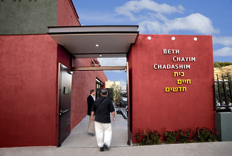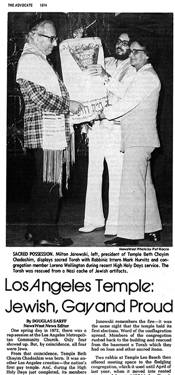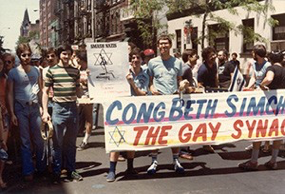
By Michal Lemberger

New York’s Congregation Beit Simchat Torah made news recently when it announced the purchase of a three-level space in a landmark tower on the west side of Manhattan. When construction is complete, the building in the Garment District will house CBST’s first permanent home in its 40-year history.

“We’ve been in a rental space that’s hard to find and reflects what the community was in the ’70s,” said Sharon Kleinbaum, senior rabbi at CBST—the country’s largest LGBT-founded synagogue, with over 1,100 adult members, up from about 650 just five years ago. “Now it will be part of the fabric of the city, out on the street, not hidden away.
Without an address, it’s hard to be a firm presence, and that’s what we want to become. We want to say that we are a vibrant part of the life of New York City and the world.”
Across the country in Los Angeles, Beth Chayim Chadashim, the country’s oldest LGBT synagogue, recently reached a similar milestone, having moved into its own new building last year and celebrating its 40th anniversary this past June.
LGBT congregations have finally come into their own, providing a home for the Jewish community’s LGBT members and their friends and families in cities both large and small. But the increasing acceptance around gay issues in mainstream synagogues, from Reconstructionist to Reform to Conservative, and even on the fringes of Modern Orthodoxy, means that these synagogues are no longer the only option for LGBT Jews. So, the lines that once seemed so clear have begun to blur: LGBT synagogues in places like Cleveland and Atlanta are merging or outgrowing their original designation and drawing a more diverse membership, even as mainstream congregations sign up new gay members and become more diverse.
According to Jay Michaelson, founder of Nehirim, an organization dedicated to LGBT spirituality, “There are some people for whom living their Jewish identity is linked to their queer identity, but for others, 2013 isn’t 1983. Most synagogues, outside of the Orthodox world, are welcoming, or at least won’t slam the door in their faces. The LGBT synagogues that used to be the default option for gay people no longer are.”
The future for LGBT synagogues, therefore, is unclear. Have they achieved the goals that led to their establishment in the first place—and if so, have they already outlived their purpose, now that mainstream synagogues have become more welcoming? Where will these synagogues be in another 40 years?
By the early 1970s, the gay-rights movement was gaining steam. Although not the first incident of its kind, the 1969 Stonewall police raid, and the riots that followed, galvanized the gay community, both in New York and nationally.
Political and advocacy organizations formed, and Gay Pride parades started marching through American cities.

But politics was not the only arena seeing a surge in LGBT-oriented institution-building. The spiritually minded, long marginalized or rejected by mainstream religious institutions, began to demand places of their own where they could come together for community and prayer. Metropolitan Community Church, the nation’s first “gay church,” and other gay-friendly Christian institutions began hosting social and religious events that drew crowds of seekers. Despite the obvious theological barriers, some Jews participated at MCC, feeling they had no other choices open to them. They had found nowhere in the established Jewish world that would allow both their gay and Jewish identities to be fully and publicly expressed.
Eventually, small clusters of predominantly gay men and a few lesbians set up synagogues of their own in cities across the country, slowly growing from shoestring operations to full-service synagogues. BCC in Los Angeles opened its doors in 1972. CBST in New York followed in 1973. By the end of the 1970s, LGBT synagogues had opened in cities all around the country. In each, marginalized LGBT groups, desiring authentic communal and spiritual spaces, formed congregations that catered to their needs.
While the earliest congregations appeared in the span of just a few years, there was no concerted effort to create a movement. Word trickled out into the national gay community that groups of people were getting together, but each nascent congregation formed independent of the others. In the very early years, they weren’t affiliated with any of the major Jewish denominations, either. No one expected any of the mainstream movements to want to add LGBT synagogues to their rosters. As a result, many within BCC were surprised when, in 1974, the Reform movement supported its bid for formal affiliation.
“The prevailing sense within the community at the time was an expectation of a negative response to the application,” according to Stephen Sass, BCC’s unofficial historian and president of the Jewish Historical Society of Southern California, “but when they went to meet with Rabbi Arnold Kaiman of the then-Union of American Hebrew Congregations, now the Union for Reform Judaism, his only question was, ‘How can we help you?’ ”
As the number of LGBT congregations around the country grew, many became affiliated with the Reform or Reconstructionist movements. Still, for decades, LGBT Jews faced a choice: They could be openly gay within LGBT synagogues, or remain closeted in mainstream congregations. The exclusion from those mainstream synagogues was real—temples and synagogues, even on the politically, socially, and religiously liberal end of the spectrum, did not welcome openly LGBT members.
While closeted individuals could attend services, and even join as members, LGBT couples and families had it harder. Partnerships were not acknowledged. Rabbis would not perform life-cycle events, such as bris or simchat bat ceremonies that named two men as fathers or two women as mothers. Even on a social level, participation could be difficult, even if just a handful of congregants were loudly uncomfortable with the presence of gay men or lesbians within the synagogue.

In the meantime, LGBT congregations focused on the work they set out to accomplish. They held Friday night and High Holiday services, as well as yearly community Seders. As the years passed, they grappled with the AIDS crisis and created ceremonies to mark the life-cycle events, tragic and joyous, reflective of the realities of their members’ lives.
Religious observance, social action, and political advocacy were entwined in the LGBT synagogue movement from the start. Founded by those who were fighting for their own legitimacy in a national culture that still enshrined homophobia in its jurisprudence and worldview, the congregations never saw themselves merely as a refuge from the larger world. Rather, as Kleinbaum stressed, they were a means to engaging with it. “We’re really addressing relevant issues of the 21st century. That comes from wisdom we’ve gained from being a gay shul,” she said, explaining CBST’s commitment to fighting not just against anti-gay bias but for the rights of immigrants, the homeless, and others.
By the 1990s, the daily reality for many LGBT Americans slowly began to shift. The drive for marriage equality was still years away, but acceptance was growing in both secular and Jewish spheres.
By the turn of the 21st century, LGBT individuals, couples, and same-sex-headed families were welcomed as full and equal participants in more liberal mainstream congregations. But the leadership lagged behind. While the Reconstructionist Movement ordained its first lesbian rabbi in 1985, and Hebrew Union College-Jewish Institute of
Religion began admitting openly LGBT students to its Reform rabbinical seminary in 1990, it took until 2007 for the Conservative movement to follow suit.
***
No longer excluded, LGBT Jews found themselves in a novel position. For the first time, they could choose where to affiliate without denying part of their identity. The degree to which this is true varies from city to city—LGBT Jews outside metropolitan areas still struggle—but in many places around the country, being openly gay and committed Jews became possible.
Examples of ways in which mainstream synagogues have reached out to LGBT Jews are not hard to find. Not only do clergy at B’nai Jeshurun, the third-oldest Ashkenazi synagogue in America, perform gay marriages, the community as a whole was vocally active in calling for the ultimately successful call to legalize same-sex marriage in New York State. Valley Beth Shalom, a large Conservative synagogue in Los Angeles, has invited LGBT families to join as members for well over a decade and publicly took a stand against homophobia after the 2001 Boy Scouts of America decision to exclude gay men from leadership positions. Synagogues in cities with smaller Jewish populations have also stepped up: Ru’ach, the havurah dedicated to serving the LGBT community at Temple Israel of Greater Miami, runs programs year-round. And, despite the discomfort of some members, Agudas Achim, in Austin, Texas, performed what they called a brit ahavah (“covenant of love”) in 2005, solemnizing the relationship of a lesbian couple, on the synagogue’s bimah.
The shifts in mainstream synagogues and denominations have had a profound effect on LGBT synagogues and temples. Those in L.A., New York, and San Francisco continue to grow and thrive. It’s not just the physical buildings. Their missions and populations have expanded, too. In addition to children’s programming, they have seen their straight-identified membership increase. While CBST does not, on principle, count its members according to sexual orientation, it now boasts a large straight contingent. San Francisco’s Sha’ar Zahav, founded in 1977, has no such qualms: One-third of its 350 member families now identify as straight, according to longtime member and former President Alex Ingersoll.
These cities are big enough to accommodate both vibrant LGBT synagogues and any number of mainstream congregations that may hold more appeal to some gay Jews. In smaller cities, the ability of LGBT Jews to choose to affiliate with institutions that may once have been closed to them has produced different results.
In Boston, for example, the local LGBT synagogue Am Tikva has been in existence since 1976, but it remains small and lay-led. Similarly, Congregation Etz Chaim in Southern Florida maintains a devoted, if largely older membership. Both Boston and Southern Florida have sizable Jewish communities, but Am Tikva and CEC do not necessarily represent the center of LGBT Jewish life in their communities. As more options open, local LGBT Jews choose synagogues to pray at and affiliate with based not solely on where they will be welcome as gay men and lesbians, but on personal preferences: type of prayer service, religious and social programming, even how much traffic they’ll have to fight on Friday nights.
In still other cities, LGBT synagogues are losing their distinctive character. In Cleveland, Chevrei Tikvah became a havurah within a large, well-established mainstream Reform congregation in 2005. And in Atlanta, Congregation Bet Haverim has embraced the gradual expansion of its mission; now the city’s only Reconstuctionist temple, it proudly touts its founding by gay men and lesbians while serving a membership of which a full 50 percent identify as straight. “We have been an incredible model of how to embrace differences and how to create a vibrant community.”
Jeri Kagel, president emerita at Bet Haverim, explained the process of opening up to more straight members. Established as an independent congregation by a group of gay men and lesbians, the synagogue began to expand its membership even before joining the Reconstructionist movement, when its progressive vision began to attract increasing numbers of non-LGBT people. Slowly, the criteria set by the congregation changed, from the demand that members had to be gay to belong to eventually abolishing all restrictions to membership.
“We have been an incredible model of how to embrace differences and how to create a vibrant community.”
“Our fear,” Kagel explained, “was that we’d be taken over, that our gay and lesbian identity would be lost, but ultimately we decided that we didn’t want to do to others what they did to us, which is not be welcoming.” But, she added, “thankfully, our fears have not been realized, and our dreams have. We have been an incredible model of how to embrace differences and how to create a vibrant community.”
Still, LGBT-oriented synagogues struggle with the same dilemmas as all other non-Orthodox congregations: Fewer and fewer people are joining as members. Even the most inclusive mainstream synagogues struggle to maintain their dues bases. The situation seems especially stark among LGBT Jews. According to Nehirim’s Michaelson, only 12 percent belong to any congregation. As Joan Schaeffer, the first lesbian president of the mainstream Temple Israel of Greater Miami said, “The Jewish community is looking for Jews. People aren’t aligning themselves with religious institutions as much as they used to, so it’s a little bit easier to be who you are these days.”
At the same time, a demographic shift began. By the 1990s, more and more nuclear families were becoming part of the fabric of the LGBT synagogue. For the first time, integrating children into synagogue life became an issue in environments that had been formed by adults. What Kleinbaum notes about CBST is true across the board: LGBT congregations “started as adult-oriented communities.” In this, they broke from the model of other liberal temples and synagogues in America, which were established to serve families with young children right from the start.
According to Steven M. Cohen, director of the Berman Jewish Policy Archive at NYU’s Robert F. Wagner Graduate School of Public Service, the number of LGBT people affiliating will only grow when they have more children, explaining, “The people who are most involved are the ones raising Jewish children, because at that point in their lives they have to reflect upon what it means to be Jewish, and they need the help of other Jews to socialize their children into Jewish life.”
***
CBST’s new building
The building that will house CBST’s new home at 130 W. 30th St.
LGBT congregations have proven themselves to be an important part of the landscape of organized Judaism. In welcoming members’ straight families and allies, they continue to teach mainstream synagogues how to become more inclusive. They have led the way in creating prayers and ceremonies that are both steeped in tradition and speak to the needs of the modern world. They dedicated themselves to social action long before it became a catchword in the broader Jewish world.
But what of the future? As liberal synagogues, both LGBT and mainstream, struggle to attract and retain members, will they band together to change the way organized Jewish life functions? Will mainstream synagogues catch up and render LGBT-identified synagogues irrelevant?
Cohen thinks so, especially because there is a significant minority of LGBT “younger adults, who are post-sexual orientation about identity.” Nehirim’s Michaelson agrees: “Generally, millennials are a generation of people not interested in self-segregation. Just being gay is boring. To choose an LGBT-specific community, there has to be another compelling reason, something more than mere identity.”
That trend will no doubt continue, but it may not presage the end of the LGBT synagogue movement. Judaism, after all, has never been uniform. It has long accommodated differences, whether between Sephardi and Ashkenazi, Orthodox and liberal, LGBT and mainstream.